Optimal Scheduling of Hybrid Multi-Carrier System Feeding Electrical/Thermal Load Based on Particle Swarm Algorithm
Abstract
:1. Introduction
2. Hub Components Modeling
3. Problem Formulation
3.1. Objective Functions
3.2. Energy Hub Constraints
4. Implementation of PSO
5. Case Study
6. Results and Discussion
6.1. Base Case
6.2. First Scenario
6.2.1. Configuration 1
6.2.2. Configuration 2
6.2.3. Configuration 3
6.3. Second Scenario
6.3.1. Configuration 1
6.3.2. Configuration 2
6.3.3. Configuration 3
- The optimization problem is based on a single day in winter, which is partitioned into 24 h intervals.
- The optimization problem is solved only for a single winter day; the same techniques can be used to define the optimal operation of the hub system for all days of a year. It is expected that the outcomes of the other seasons of a year may be significantly different due to changing load profiles and unpredictable extracted energy from PVs and WTs. These will be profoundly affected by the electricity exchange, with the main electric grid and the generated energy from different hub elements.
- The operation of the energy hub is assumed to be based on constant hub efficiencies.
- It will be more realistic to consider time-varying efficiencies. It is expected the total operating expenses will be increased because efficiencies of hub devices are dropped as their consumed powers are decreased.
- Neglecting the effect of the CO2 penalty factor on the optimization problem.
- The penalty factor will add a further burden to the overall operating costs of the system. According to the World Bank’s Carbon Pricing Watch report, the penalty factor for CO2 emissions is about 10–15 USD/ton CO2 [34].
- Considering only the carbon footprint evaluation to assess the environmental impacts of the hub system and neglecting the life cycle assessment (LCA = 0).
- Carbon footprint is a monocriterion assessment that focuses on greenhouse gas emissions of the system. LCA assesses multiple environmental influences attributable to the life cycle of the materials, including greenhouse gases, acidification, particulate matter formation, resource depletion, and end-of-life disposal etc., and an LCA evaluation technique will be a useful supporting tool for identifying the gross environmental effects of the hub system.
7. Conclusions
Author Contributions
Funding
Acknowledgments
Conflicts of Interest
References
- Chung, T.; Li, X.; Ong, R.C.; Ge, Q.; Wang, H.; Han, G. Emerging forward osmosis (FO) technologies and challenges ahead for clean water and clean energy applications. Curr. Opin. Chem. Eng. 2012, 1, 246–257. [Google Scholar] [CrossRef]
- Bostan, A.; Nazar, M.S.; Shafie-Khah, M.; Catalão, J.P. Optimal scheduling of distribution systems considering multiple downward energy hubs and demand response programs. Energy 2020, 190, 116349. [Google Scholar] [CrossRef]
- Mohammadi, M.; Noorollahi, Y.; Mohammadi-Ivatloo, B.; Yousefi, H. Energy hub: From a model to a concept-a review. Renew. Sustain. Energy Rev. 2017, 80, 1512–1527. [Google Scholar] [CrossRef]
- Fan, S.; Li, Z.; Wang, J.; Piao, L.; Ai, Q. Cooperative economic scheduling for multiple energy hubs: A bargaining game theoretic perspective. IEEE Access 2018, 6, 27777–27789. [Google Scholar] [CrossRef]
- Kiciński, J. Do we have a chance for small-scale energy generation? The examples of technologies and devices for distributed energy systems in micro & small scale in Poland. Bull. Pol. Acad. Sci. Tech. Sci. 2013, 61, 749–756. [Google Scholar] [CrossRef]
- Segurado, R.; Pereira, S.; Correia, D.; Costa, M. Techno-economic analysis of a trigeneration system based on biomass gasification. Renew. Sustain. Energy Rev. 2019, 103, 501–514. [Google Scholar] [CrossRef]
- Wang, H.; Zhang, H.; Gu, C.; Li, F. Optimal design and operation of CHPs and energy hub with multi objectives for a local energy system. Energy Procedia 2017, 142, 1615–1621. [Google Scholar] [CrossRef]
- Wang, Y.; Zhang, N.; Zhuo, Z.; Kang, C.; Kirschen, D. Mixed-integer linear programming-based optimal configuration planning for energy hub: Starting from scratch. Appl. Energy 2018, 210, 1141–1150. [Google Scholar] [CrossRef]
- Jurasz, J.; Mikulík, J. Economic and environmental analysis of a hybrid solar, wind and pumped storage hydroelectric energy source: A Polish perspective. Bull. Pol. Acad. Sci. Tech. Sci. 2017, 65, 859–869. [Google Scholar] [CrossRef] [Green Version]
- Di Somma, M.; Yan, B.; Bianco, N.; Luh, P.B.; Graditi, G.; Mongibello, L.; Naso, V. Multi-objective operation optimization of a Distributed Energy System for a large-scale utility customer. Appl. Therm. Eng. 2016, 101, 752–761. [Google Scholar] [CrossRef]
- Zhong, Y.; Xie, D.; Zhai, S.; Sun, Y. Day-ahead hierarchical steady state optimal operation for integrated energy system based on energy hub. Energies 2018, 11, 2765. [Google Scholar] [CrossRef] [Green Version]
- Ranjbar, A.M.; Moshari, A.; Oraee, H.; Sheikhi, A. Optimal operation and size for an energy hub with CCHP. Energy Power Eng. 2011, 3, 641–649. [Google Scholar] [CrossRef] [Green Version]
- Qi, F.; Wen, F.; Liu, X.; Salam, A. A residential energy hub model with a concentrating solar power plant and electric vehicles. Energies 2017, 10, 1159. [Google Scholar] [CrossRef] [Green Version]
- Liu, J.; Li, J.; Xiang, Y.; Hu, S. Optimal Sizing of Hydro-PV-Pumped Storage Integrated Generation System Considering Uncertainty of PV, Load and Price. Energies 2019, 12, 3001. [Google Scholar] [CrossRef] [Green Version]
- Das, B.K.; Al-Abdeli, Y.M. Optimization of stand-alone hybrid CHP systems meeting electric and heating loads. Energy Convers. Manag. 2017, 153, 391–408. [Google Scholar]
- Amir, V.; Jadid, S.; Ehsan, M. Optimal Planning of a Multi-Carrier Microgrid (MCMG) Considering Demand-Side Management. Int. J. Renew. Energy Res. 2018, 8, 238–249. [Google Scholar]
- Malakoti-Moghadam, M.; Askarzadeh, A.; Rashidinejad, M. Transmission and generation expansion planning of energy hub by an improved genetic algorithm. Energy Sources Part A Recover. Util. Environ. Eff. 2019, 41, 3112–3126. [Google Scholar] [CrossRef]
- Urbanucci, L.; Testi, D. Optimal integrated sizing and operation of a CHP system with Monte Carlo risk analysis for long-term uncertainty in energy demands. Energy Convers. Manag. 2018, 157, 307–316. [Google Scholar] [CrossRef]
- Huang, Y.; Zhang, W.; Yang, K.; Hou, W.; Huang, Y. An optimal scheduling method for multi-energy hub systems using game theory. Energies 2019, 12, 2270. [Google Scholar] [CrossRef] [Green Version]
- Lorestani, A.; Pouresmaeil, E.; Nazari, M.H. Optimal sizing and techno-economic analysis of energy- and cost-efficient standalone multi-carrier microgrid. Energy 2019, 178, 751–764. [Google Scholar] [CrossRef]
- Moghaddas-Tafreshi, S.M.; Mohseni, S.; Karami, M.E.; Kelly, S. Optimal energy management of a grid-connected multiple energy carrier micro-grid. Appl. Therm. Eng. 2019, 152, 796–806. [Google Scholar] [CrossRef]
- Conti, P.; Lutzemberger, G.; Schito, E.; Poli, D.; Testi, D. Multi-Objective Optimization of Off-Grid Hybrid Renewable Energy Systems in Buildings with Prior Design-Variable Screening. Energies 2019, 12, 3026. [Google Scholar] [CrossRef] [Green Version]
- Huang, Y.; Yang, K.; Zhang, W.; Lee, K. Hierarchical energy management for the multienergy carriers system with different interest bodies. Energies 2018, 11, 2834. [Google Scholar] [CrossRef] [Green Version]
- Abdelshafy, A.M.; Hassan, H.; Jurasz, J. Optimal design of a grid-connected desalination plant powered by renewable energy resources using a hybrid PSO–GWO approach. Energy Convers. Manag. 2018, 173, 331–347. [Google Scholar] [CrossRef]
- Parol, M.; Rokicki, L.; Parol, R. Towards optimal operation control in rural low voltage microgrids. Bull. Pol. Acad. Sci. Tech. Sci. 2019, 67, 799–812. [Google Scholar]
- Moeini-Aghtaie, M.; Dehghanian, P.; Fotuhi-Firuzabad, M.; Abbaspour, A. Multiagent genetic algorithm: An online probabilistic view on economic dispatch of energy hubs constrained by wind availability. IEEE Trans. Sustain. Energy 2013, 5, 699–708. [Google Scholar] [CrossRef]
- Roldán-Blay, C.; Miranda, V.; Carvalho, L.; Roldán-Porta, C. Optimal Generation Scheduling with Dynamic Profiles for the Sustainable Development of Electricity Grids. Sustainability 2019, 11, 7111. [Google Scholar] [CrossRef] [Green Version]
- Dai, Q.; Liu, J.; Wei, Q. Optimal photovoltaic/battery energy storage/electric vehicle charging station design based on multi-agent particle swarm optimization algorithm. Sustainability 2019, 11, 1973. [Google Scholar] [CrossRef] [Green Version]
- Zhang, D. Optimal Design and Planning of Energy Microgrids. Ph.D. Thesis, University College London, London, UK, 2014. [Google Scholar]
- SENTECH Incorporated. Commercial and industrial CHP technology cost and performance data analysis for EIA. 2010. Available online: http://capabilities.itron.com/efg/2011/EIA2010ComIndCHPTechCostandPerformance0831.pdf (accessed on 2 June 2020).
- Wu, X.; Wang, X.; Qu, C. A Hierarchical Framework for Generation Scheduling of Microgrids. IEEE Trans. Power Deliv. 2014, 29, 2448–2457. [Google Scholar] [CrossRef]
- Zou, K.; Agalgaonkar, A.P.; Muttaqi, K.M.; Perera, S. Distribution System Planning With Incorporating DG Reactive Capability and System Uncertainties. IEEE Trans. Sustain. Energy 2011, 3, 112–123. [Google Scholar] [CrossRef]
- Clegg, S.; Mancarella, P. Integrated electrical and gas network modelling for assessment of different power-and-heat options. In Proceedings of the 2014 Power Systems Computation Conference, Wroclaw, Poland, 18–22 August 2014; pp. 1–7. [Google Scholar]
- ElAzab, H.-A.; Swief, R.A.; El-Amary, N.H.; Temraz, H.K. Unit Commitment Towards Decarbonized Network Facing Fixed and Stochastic Resources Applying Water Cycle Optimization. Energies 2018, 11, 1140. [Google Scholar] [CrossRef] [Green Version]

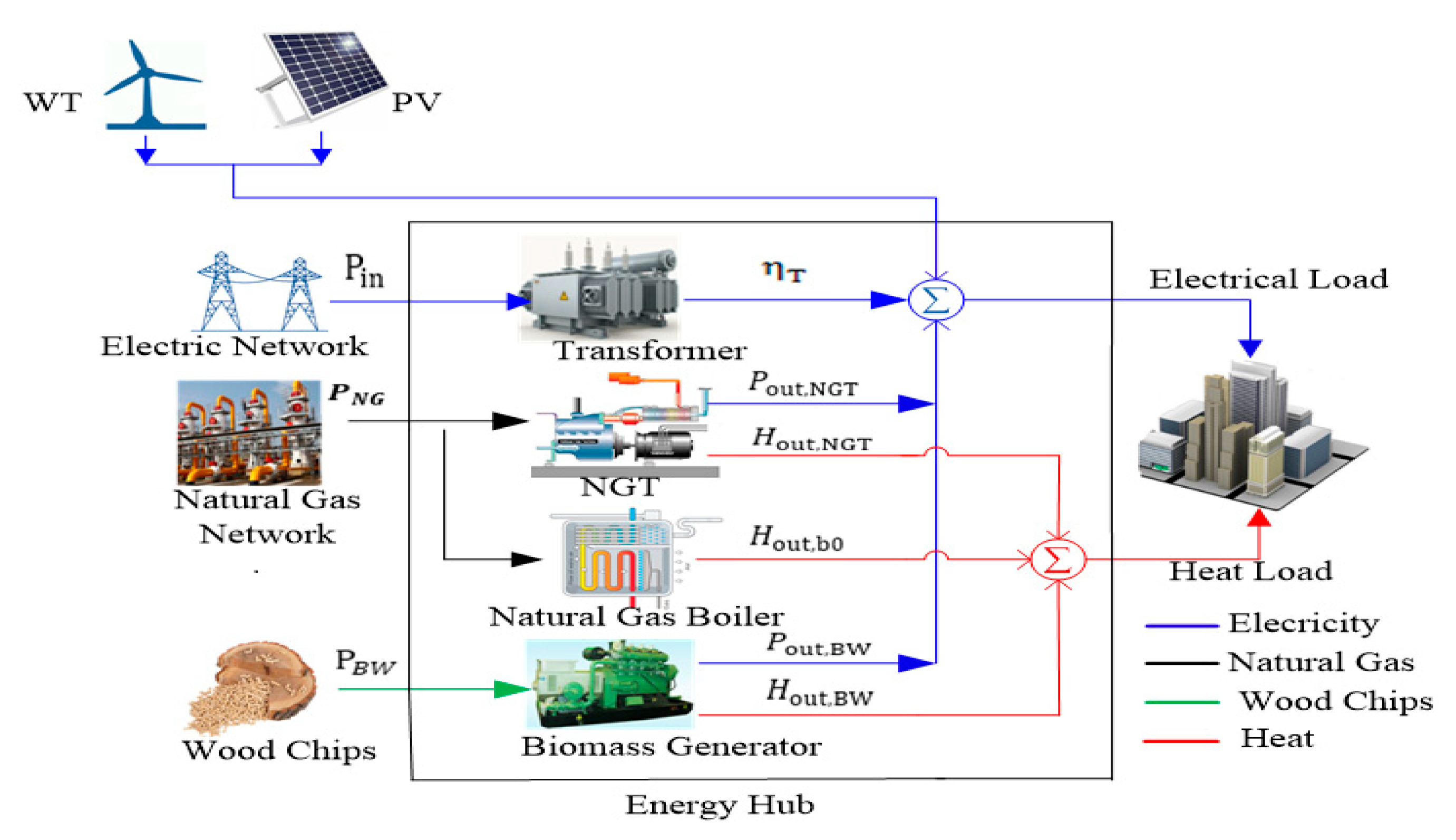

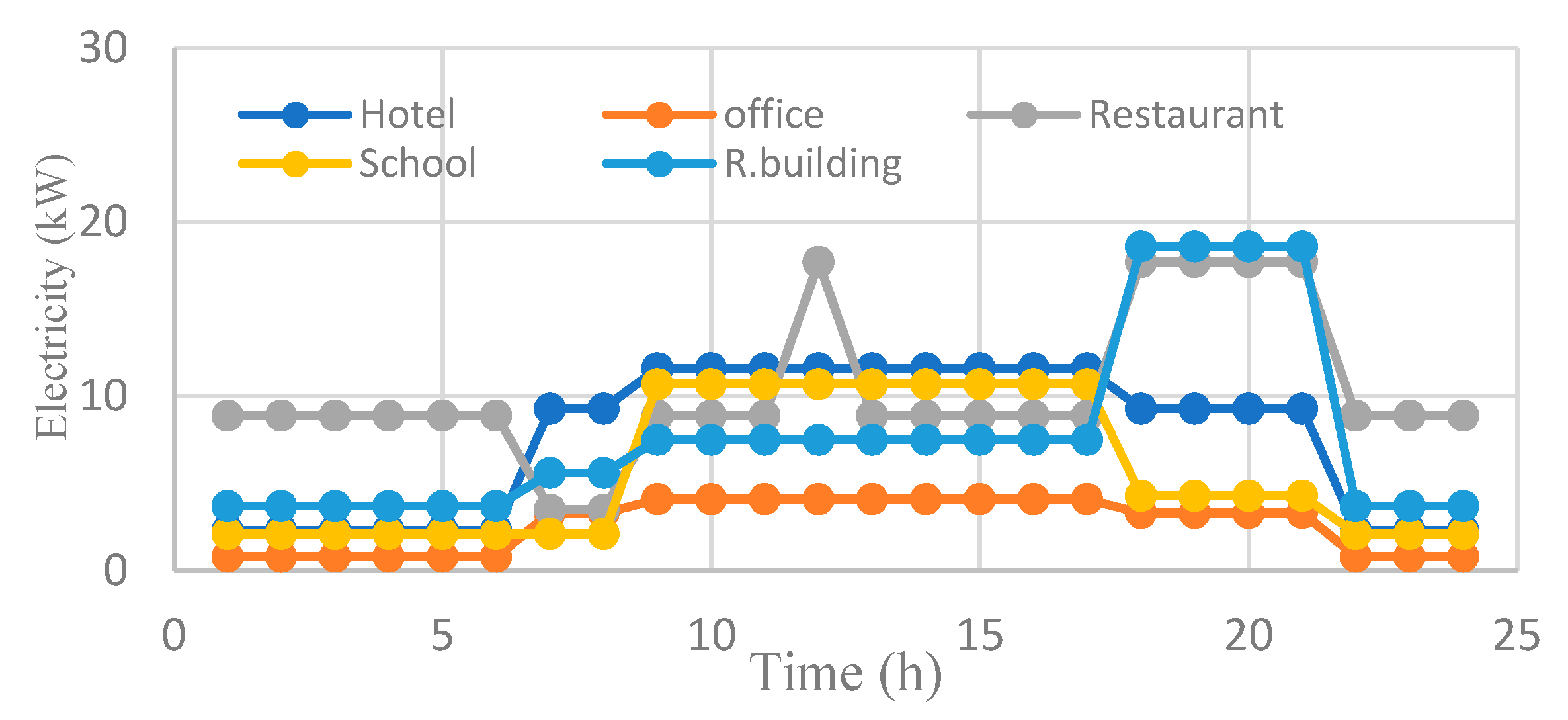




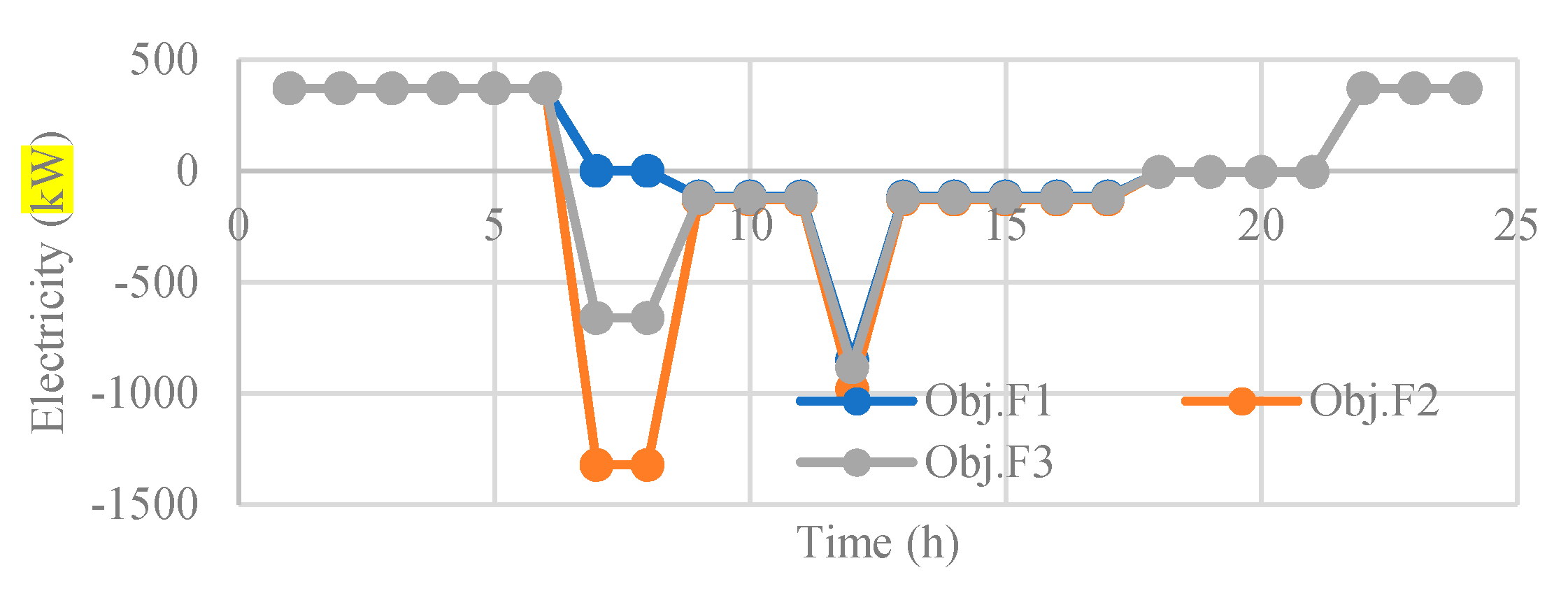
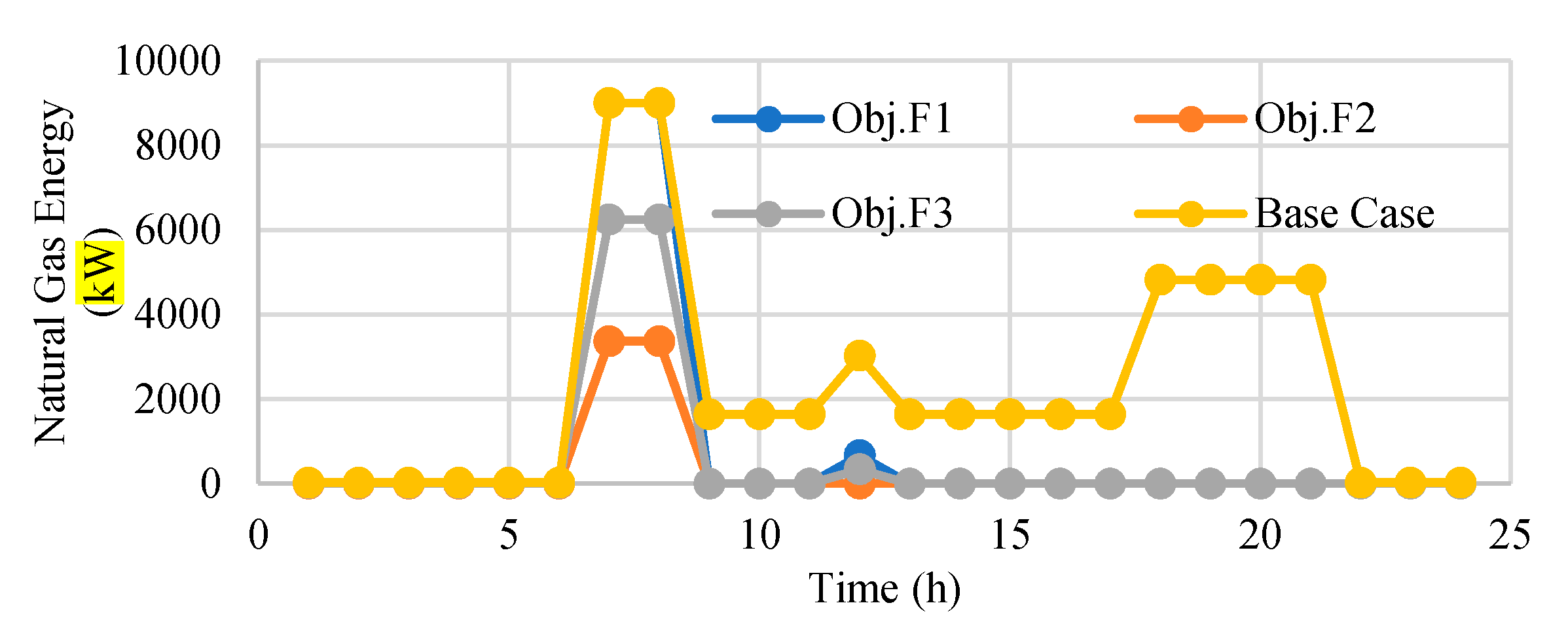


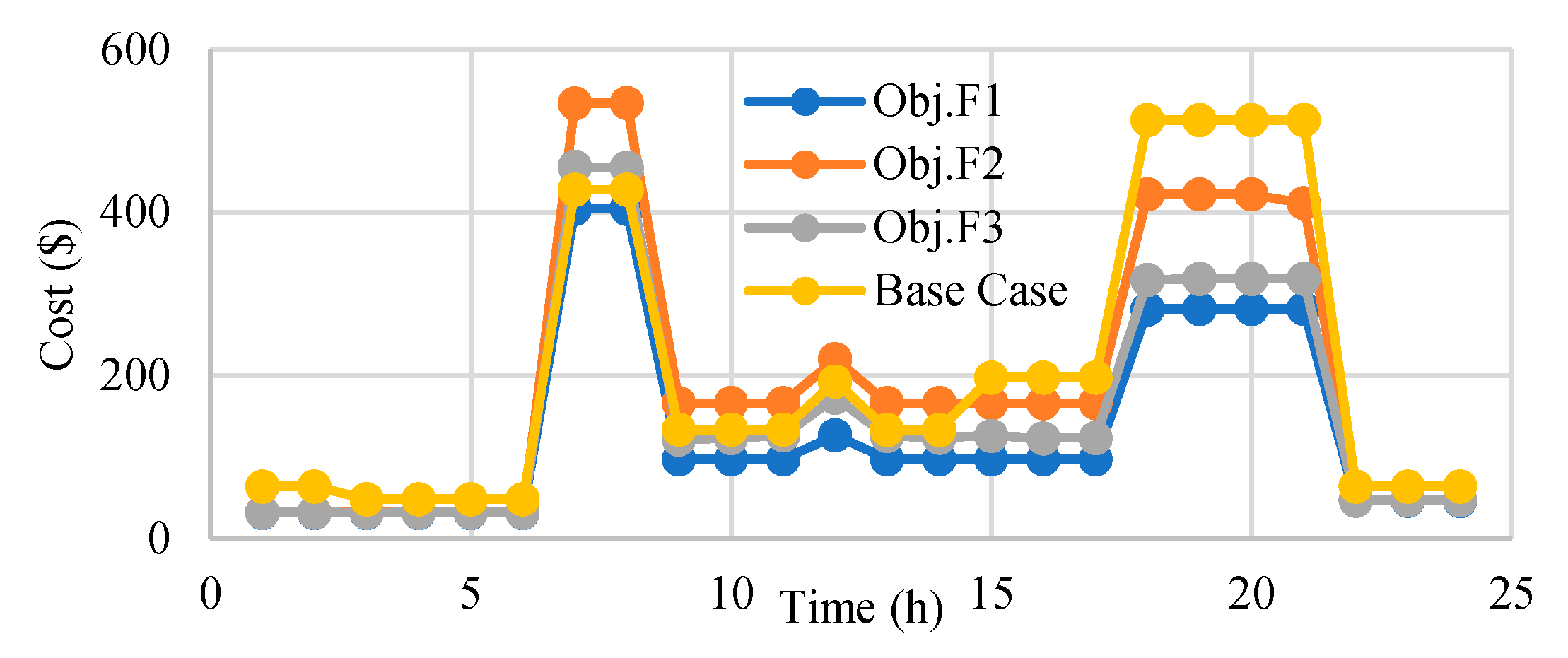
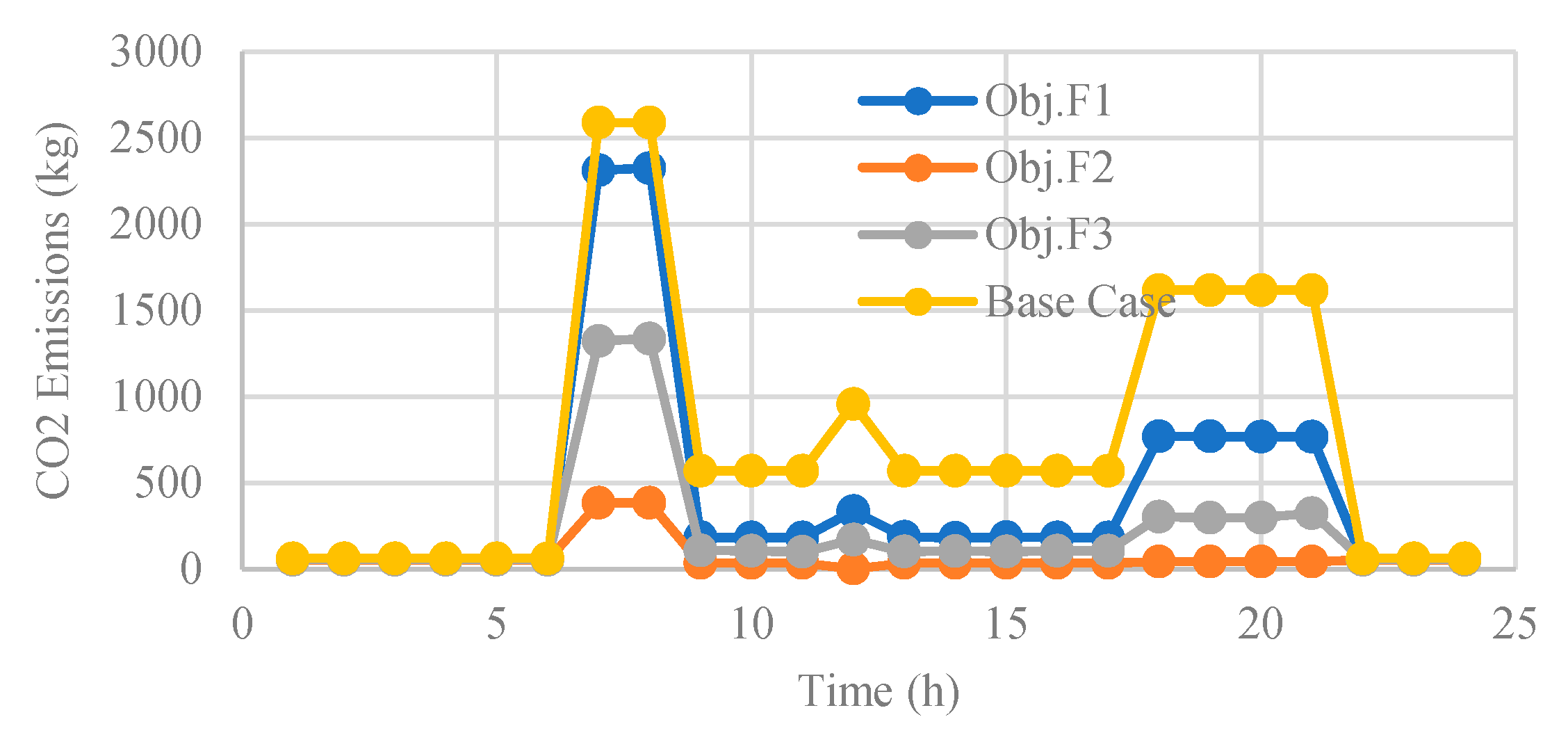
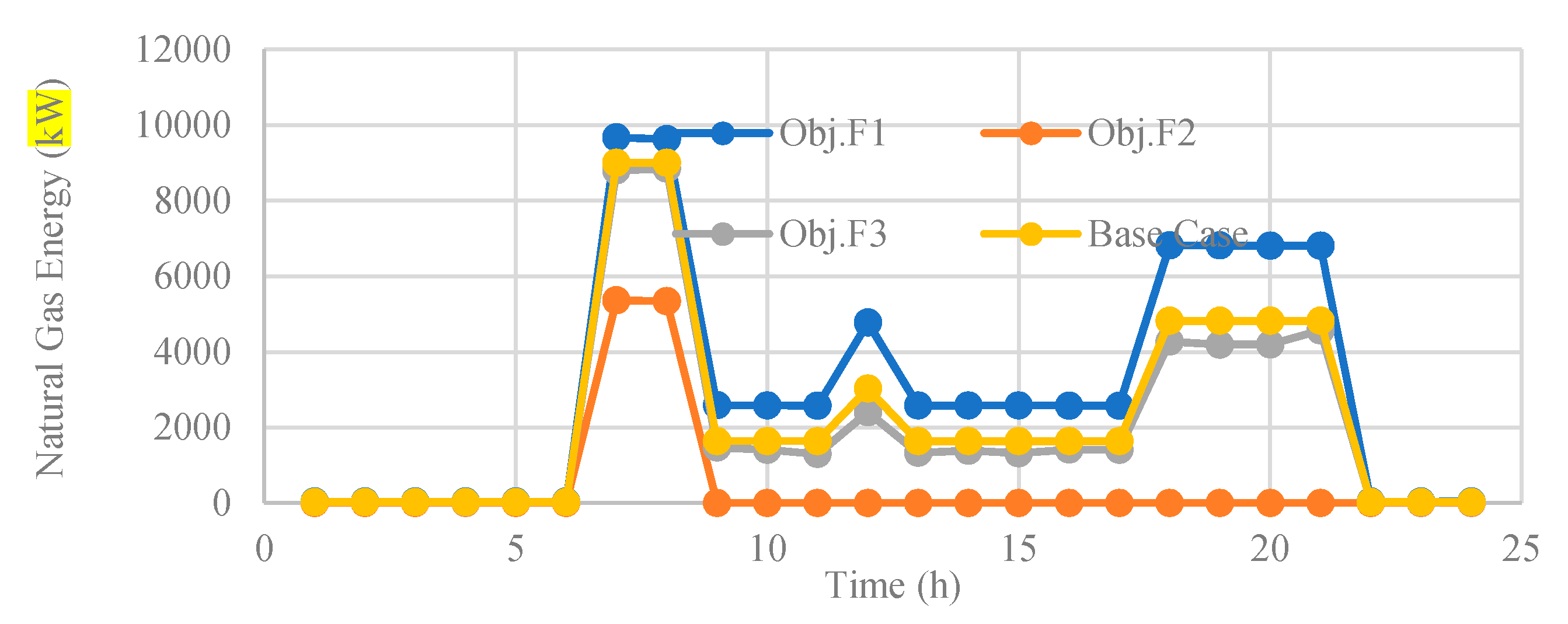

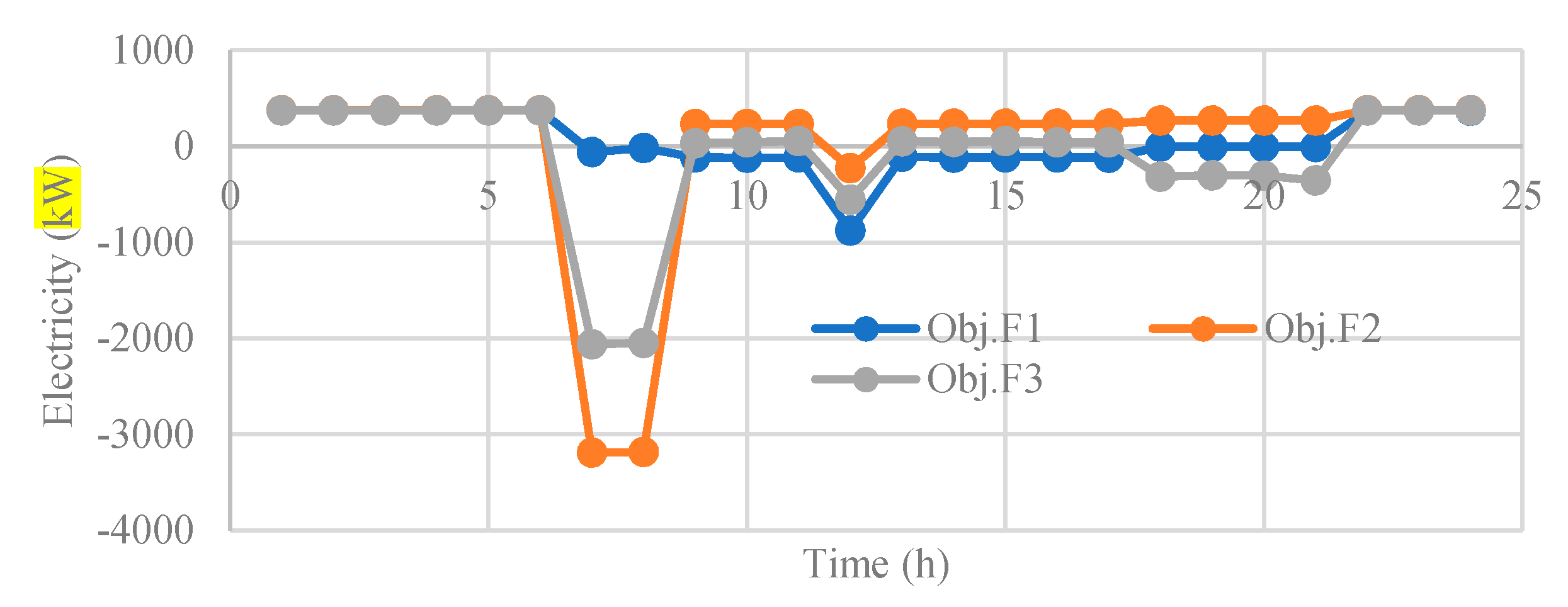
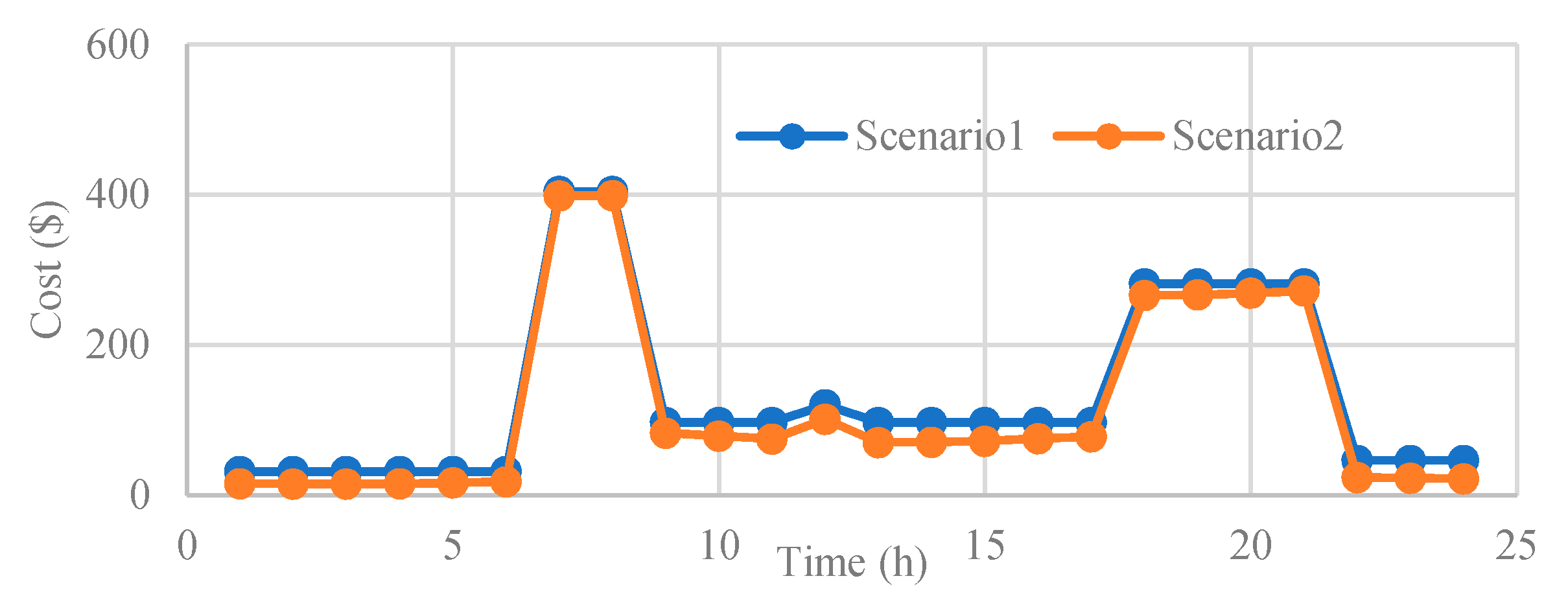






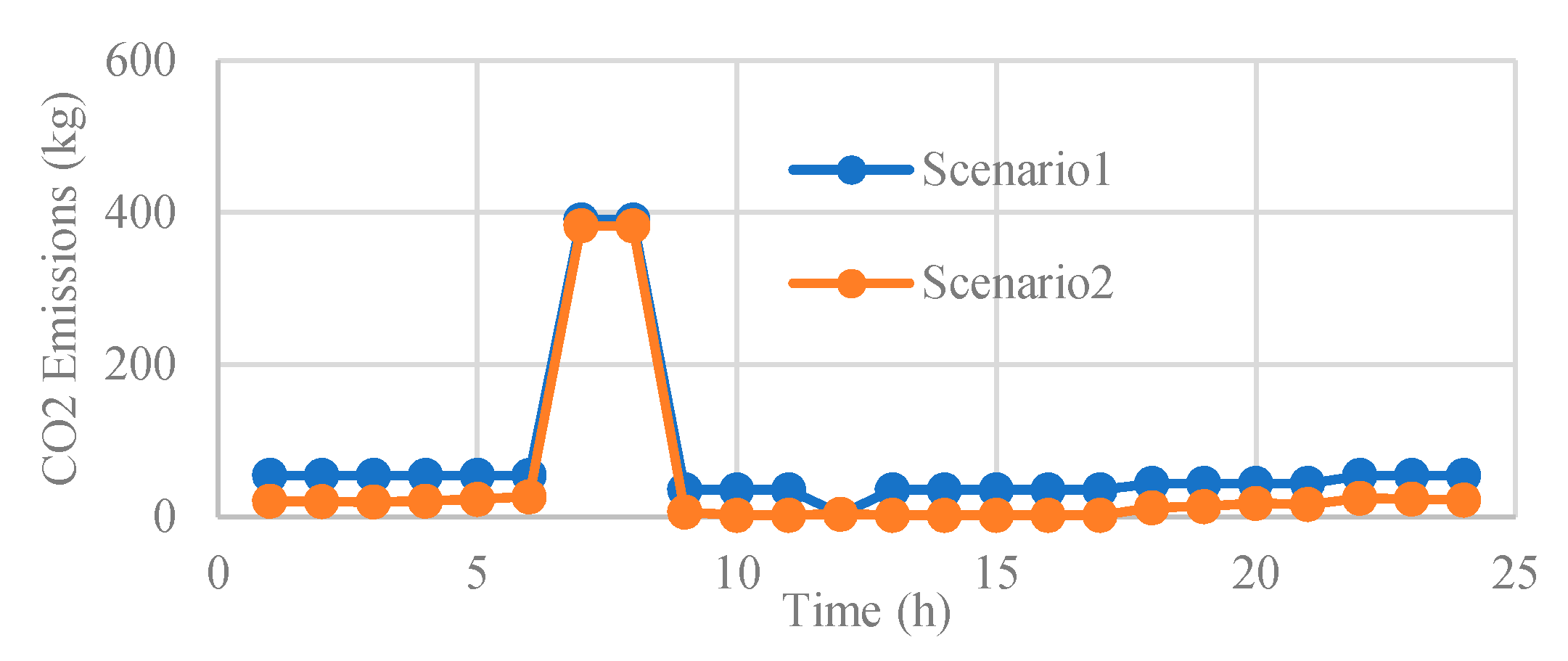
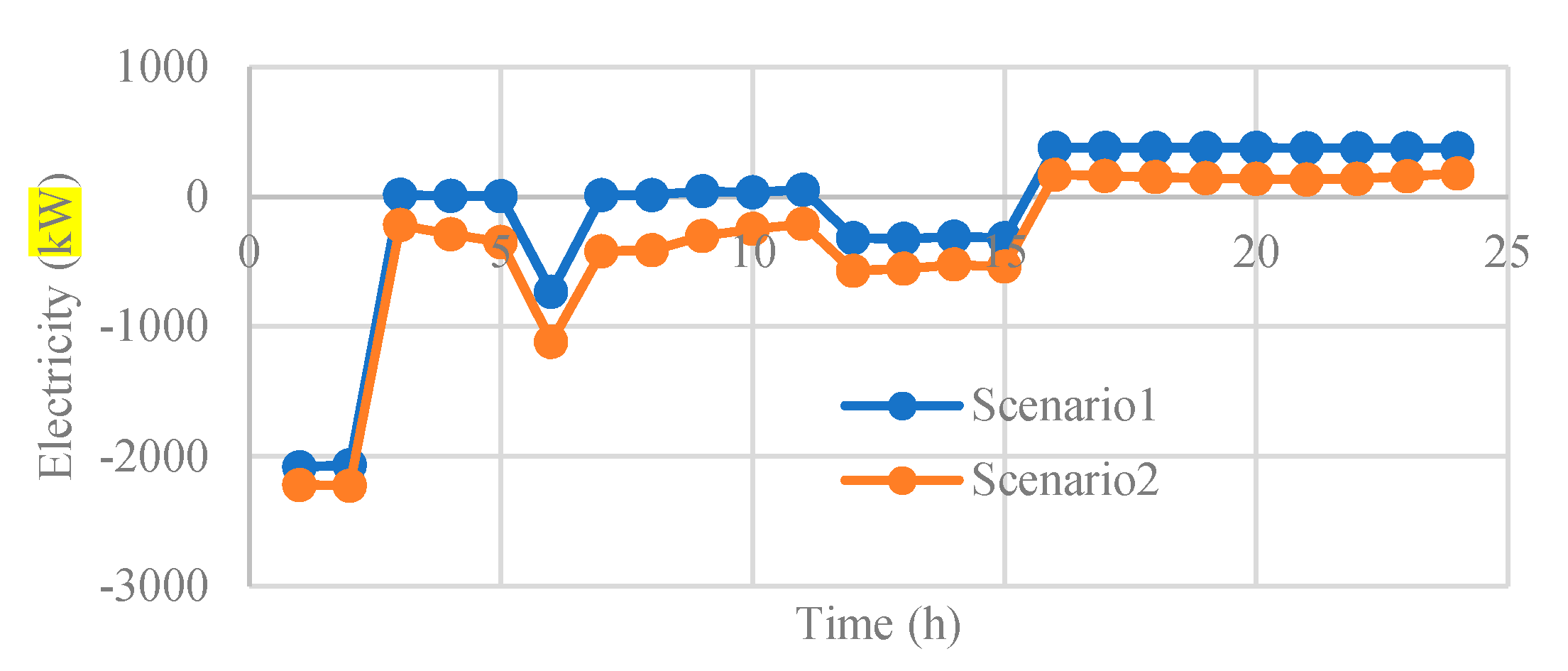
| Par. | Value | Par. | Value ($/kWh) | Par. | Value (kgCO2/kWh) |
|---|---|---|---|---|---|
| 0.35 [30] | 0.04 [31] | 0.143 | |||
| 0.48 [30] | 0.063 [32] | 0.003 [32] | |||
| 0.285 [32] | 0.003 [30] | 0.2016 | |||
| 0.642 [32] | 0.012 [32] | 0.3661 | |||
| 1.0 | 0.003 [30] | ||||
| 0.76 [33] | 0.01 [31] |
| Using Time | Off-Peak1 (00–08) | Peak (08–20) | Off-Peak 2 (20–24) |
|---|---|---|---|
| 0.08 | 0.16 | 0.12 | |
| 0.04 | 0.08 | 0.06 |
| Scenario | First Scenario Without PVs and WTs | Second Scenario With PVs and WTs | ||||
|---|---|---|---|---|---|---|
| Conf. | 1 | 2 | 3 | 1 | 2 | 3 |
| Boiler | √ | √ | √ | √ | √ | √ |
| NGT | √ | √ | √ | √ | ||
| Biomass | √ | √ | √ | √ | ||
| Cost ($) | CO2 Emission (kg) | (MWh) | (MWh) | (MWh) | (MWh) |
|---|---|---|---|---|---|
| 4871 | 17,729 | 53.6 | 19.27 | 0 | 40.7 |
| Obj. fun | Cost ($) | CO2 Emission (kg) | (MWh) | (MWh) | (MWh) | (MWh) | (MWh) |
|---|---|---|---|---|---|---|---|
| base | 4871 | 17,729 | 53.6 | 19.27 | 0 | 0 | 40.7 |
| F1 | 3158 | 10,042 | 72.4 | 3.34 | 1.87 | 24.4 | 16.3 |
| F2 | 3161 | 9248 | 75.2 | 3.34 | 4.52 | 28 | 12.7 |
| F3 | 3159 | 9645 | 73.7 | 3.34 | 3.2 | 26.6 | 14.5 |
| Obj.fun | Cost ($) | CO2 Emission (kg) | (MWh) | (MWh) | (MWh) | (MWh) | (MWh) | (MWh) |
|---|---|---|---|---|---|---|---|---|
| F1 | 4376 | 6346 | 18.8 | 41.2 | 7.53 | 0 | 26.4 | 14.3 |
| F2 | 4622 | 2825 | 6.7 | 55.5 | 6.32 | 2.87 | 35.6 | 5.1 |
| F3 | 4487 | 4536 | 12.9 | 48.2 | 6.35 | 0.82 | 30.9 | 9.8 |
| Obj. fun | Cost ($) | CO2 Emission (kg) | (MWh) | (MWh) | (MWh) | (MWh) | (MWh) | (MWh) | (MWh) | (MWh) | (MWh) |
|---|---|---|---|---|---|---|---|---|---|---|---|
| F1 | 3162 | 10,018.5 | 72.3 | 0.1 | 3.34 | 1.9 | 17.8 | 0.03 | 24.4 | 0.07 | 16.25 |
| F2 | 4625 | 1708.8 | 10.7 | 55.46 | 6.32 | 6.6 | 3.74 | 15.81 | 5.1 | 35.6 | 0.008 |
| F3 | 3676 | 5382.4 | 48.5 | 24.27 | 3.7 | 5.9 | 14.6 | 6.9 | 20 | 15.58 | 5.16 |
| Obj fun | Cost ($) | CO2 Emission (kg) | (MWh) | (MWh) | (MWh) | (MWh) | (MWh) |
|---|---|---|---|---|---|---|---|
| F1 | 2728 | 9865.4 | 72 | 1.33 | 5.53 | 23.9 | 16.8 |
| F2 | 2731 | 8960.6 | 75 | 1.33 | 8.54 | 28 | 12.7 |
| F3 | 2730 | 9413 | 73.6 | 1.33 | 7 | 25.9 | 14.8 |
| Obj. fun | Cost ($) | CO2 Emission (kg) | (MWh) | (MWh) | (MWh) | (MWh) | (MWh) | (MWh) |
|---|---|---|---|---|---|---|---|---|
| F1 | 3721 | 6458 | 21.8 | 37.6 | 2.51 | 0 | 24.13 | 16.57 |
| F2 | 3985 | 2160 | 67.4 | 55.5 | 1.67 | 4.24 | 35.6 | 5.1 |
| F3 | 3836 | 4287 | 14.4 | 46.4 | 1.69 | 1.68 | 29.8 | 10.9 |
| Obj. fun | Cost ($) | CO2 Emission (kg) | (MW) | (MWh) | (MWh) | (MWh) | (MWh) | (MWh) | (MWh) | (MWh) | (MWh) |
|---|---|---|---|---|---|---|---|---|---|---|---|
| F1 | 2732 | 9857.3 | 71.8 | 0.114 | 1.31 | 5.5 | 17.4 | 0.03 | 23.8 | 0.07 | 16.83 |
| F2 | 3988 | 1043.6 | 10.7 | 55.5 | 1.67 | 7.98 | 3.74 | 15.81 | 5.1 | 35.6 | 0.008 |
| F3 | 3205 | 5117.3 | 49.1 | 23.7 | 1.35 | 9.64 | 14.77 | 6.76 | 20.3 | 15.2 | 5.2 |
© 2020 by the authors. Licensee MDPI, Basel, Switzerland. This article is an open access article distributed under the terms and conditions of the Creative Commons Attribution (CC BY) license (http://creativecommons.org/licenses/by/4.0/).
Share and Cite
Farah, A.; Hassan, H.; M. Abdelshafy, A.; M. Mohamed, A. Optimal Scheduling of Hybrid Multi-Carrier System Feeding Electrical/Thermal Load Based on Particle Swarm Algorithm. Sustainability 2020, 12, 4701. https://doi.org/10.3390/su12114701
Farah A, Hassan H, M. Abdelshafy A, M. Mohamed A. Optimal Scheduling of Hybrid Multi-Carrier System Feeding Electrical/Thermal Load Based on Particle Swarm Algorithm. Sustainability. 2020; 12(11):4701. https://doi.org/10.3390/su12114701
Chicago/Turabian StyleFarah, Alaa, Hamdy Hassan, Alaaeldin M. Abdelshafy, and Abdelfatah M. Mohamed. 2020. "Optimal Scheduling of Hybrid Multi-Carrier System Feeding Electrical/Thermal Load Based on Particle Swarm Algorithm" Sustainability 12, no. 11: 4701. https://doi.org/10.3390/su12114701





